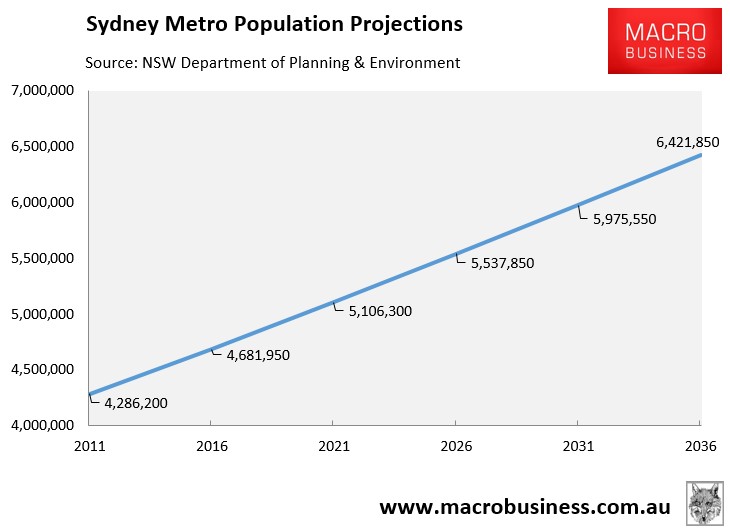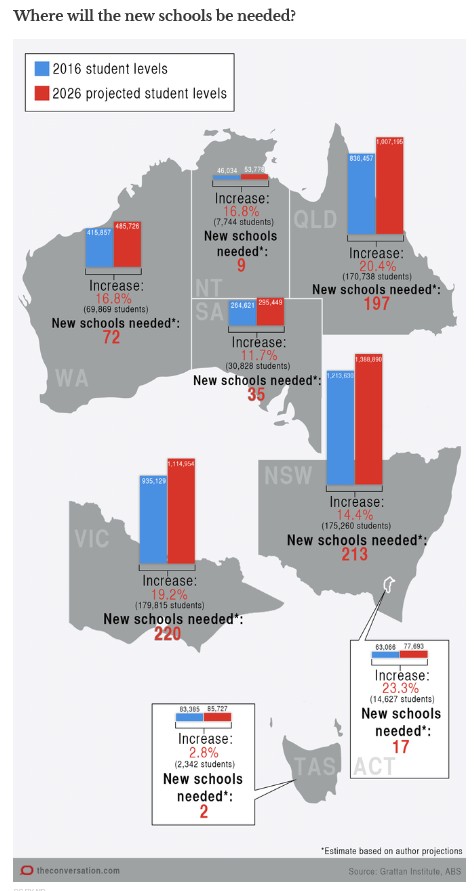The lack of planning and foresight to cope with the never-ending population (immigration) influx never ceases to amaze.
In the decade to 2015, Sydney’s population grew by just over 700,000 people or by 17% – the equivalent of almost two Canberra’s.
And the NSW Government’s official population projections have Sydney’s population growing by 1,650 people per week (87,000 people per year) over the next 20 years – total population growth of 1.74 million people, which is the equivalent of 4.5 Canberra’s:

The collateral damage from this high immigration program has been felt far and wide, ranging from worsening traffic congestion, deteriorating housing affordability, and the overall erosion of public services.
One such area that has been badly affected is Sydney’s public schools, which are now suffering from chronic over-crowding as they struggle to keep pace with the rampant population growth. From The ABC:
A Sydney school where running at recess is banned because of overcrowding has been told the State Government is scaling back a promised expansion, which means students will not get extra play space…
In the past ten years the school has almost doubled in size to 1,200 students…
The NSW State Government acknowledges it is facing an unprecedented level of student enrolments.
It is currently allocating funding for nearly 50 schools to be either built or redeveloped.
But student numbers are expected to increase by nearly 25 per cent by 2031.
“Particularly in Sydney where there are new apartment blocks going up in Sydney all the time,” said Joan Lemaire from the Teachers Federation.
“We definitely need the Government to step in and begin a much bigger building program.
“We see that as a priority, maybe a priority bigger than building roads and railways.”
The school funding shortfall to deal with population growth is estimated by the auditor general to be as much as $10 billion.
Back in February, Peter Goss, School Education Program Director at the Grattan Institute, penned an excellent article in The Conversation assessing the upcoming shortage of schools across Australia’s capital cities as the nation’s population balloons. This article estimated that the number of school students would balloon by 650,000 (17%) by 2026, which would require the building of an additional 400 to 750 new schools (up from 9,400 currently). NSW (mostly Sydney) would need an additional 220 schools to cope with an additional 19% of students over the next decade, whereas Victoria (mostly Melbourne) would require an additional 220 schools to cope with an additional 19% of students (see below graphic).

All of this, yet again, highlights Australia’s dysfunctional population ponzi.
The Federal Government massively ramped-up immigration from 2003 which, when combined with the mini baby boom encouraged by the baby bonus, is leading to surging demand for schooling.
However, the states have been unable to accommodate this growth – due in part to incompetence, but also through lack of funds courtesy of Australia’s famous vertical fiscal imbalance, whereby the federal government collects most of the revenue.
This dysfunction is arguably most apparent across inner city areas. The states have been successful in forcing urban consolidation and infill development, as evidenced by the proliferation of apartment development across our major cities. However, they have been totally unsuccessful in providing the necessary infrastructure to accommodate this growth, be it schools, hospitals or transport infrastructure.
To make matters even worse, the Turnbull Government recently relaxed visa rules to allow 6 year-old foreign students and their guardians visa entry into Australia’s primary schools, thus adding to the demand pressures.
Running a high immigration program without adequate planning and investment means incumbent residents will spend more time lost in traffic, spend more on (smaller) housing, receive less public services (e.g. health and education), and experience overall lower living standards.
The equation is that simple, but ignored by our mainstream politicians and policy makers, who prefer to take the short-term sugar hit from growth while incumbent residents suffer the long-term consequences.

